Pictured Above: Marijke Ellert enjoys the therapeutic aspect of farriery. “I love ... coming up with out-of-the-box ideas and applying them to a horse.”
"And though she be but little, she is fierce.”
Helena famously described Hermia this way in A Midsummer’s Night Dream. In fact, since William Shakespeare’s words first were uttered on stage in the late 1500s, it’s been used countless times to describe people and things. When Placerville, Calif., farrier Marijke Ellert opens up her rig, the quote is there for all to see, emblazoned on the back wall. The word “FIERCE” is prominent by appearing in all capital letters.
It’s a statement to be sure. When one thinks of the word fierce, it might evoke thoughts of a wild animal or a violent individual. Another definition of the word is furiously eager or intense. It aptly describes Ellert’s passion for the trade that she’s a part of, not to mention her clients — the horses.
8:18 a.m. Ellert greets her apprentice Carlina Grey as she emerges from her Northern California home for another day of “Shoeing For A Living.” Grey loads her tools and pink Hoofjack into Ellert’s Stonewell drop-in unit and jumps into the red Dodge Ram 2500.
After a 30-minute drive, Ellert maneuvers her pickup off the main road and onto a dirt driveway. Six trims — a Belgian mare, a trio of saddle horses and two minis — await on the Shingle Springs property.
“The owner has horses that she uses as some kind of therapy or counseling,” Ellert says, “where she brings a group of women out and has them introduce themselves to the horses and through their interactions learn about themselves.”
Farrier Takeaways
- Holding a miniature horse’s front leg behind the knee allows for greater control and leverage.
- Using right- and left-handed hoof knives makes it easier to access both sides of the frog.
- Finding the true apex of the frog helps locate anatomical landmarks, as well as how much sole and heels needs to be trimmed.
- Keeping a sore limb closer to the ground while trimming makes the horse much more comfortable.
- It’s important to keep up on how your clients fare in the show ring to help the horse perform up to its best abilities.
As Ellert and Grey hop out of the truck and ready their tools, Dan Dietrich, the manager of the property, arrives and exchanges pleasantries. The soft-spoken Dietrich leads the pair past a covered arena and through a stable to an area where Grey will trim the minis.
“Her flexor tendon is a little contracted, so I wouldn’t get super aggressive with taking heel,” Ellert says pointing to the flea-bitten gray mini as she advises her apprentice. “You can take some back, but if you take too much she tends to not bear weight on her heels. The other one can be trimmed normally.”
8:58 a.m. Dietrich leads Ellert to an adjacent stable where she’ll trim the remaining four horses.
Bella, the Belgian mare, is the first one up.
“We try to keep her on close to a 4-week schedule because her feet tend to chip up real bad otherwise,” says Ellert, who earned her CJF from the American Farrier’s Association (AFA) in 2010. “We went a little longer with her, so they’ve gotten chippy. So, I’m going to be conservative trimming her. I’m not going to take a ton since she’s so heavy. I want to leave as much foot as possible. By the next time we come out, I’ll be able to pretty it up some more. Just try to get the ragged edges off today.
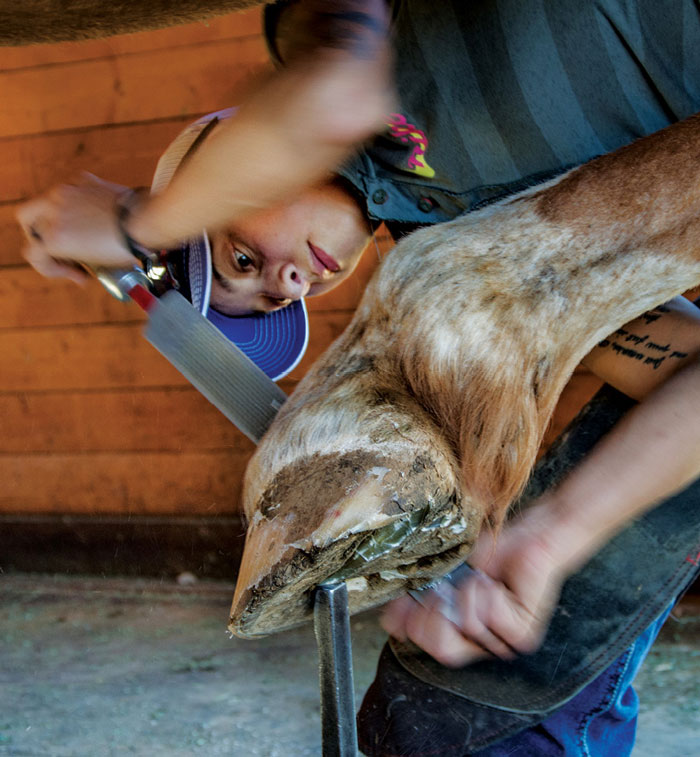
Ellert uses her small frame to her advantage when trimming horses such as Bella. The Belgian mare has a tendency to get sore if Ellert doesn’t keep the horse’s leg close up underneath her.
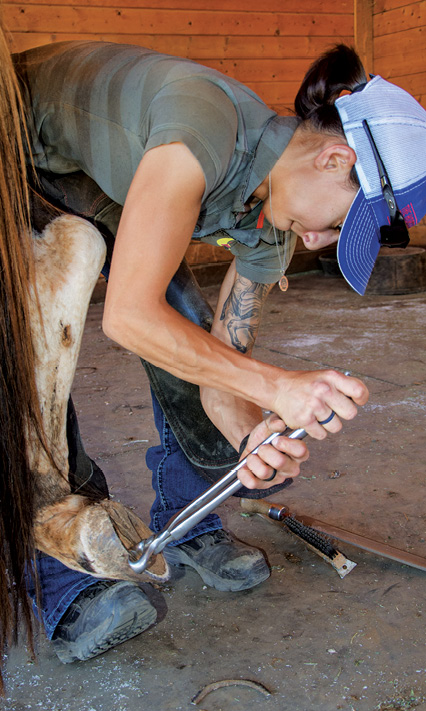
To avoid pain and discomfort in Harley’s hind end, Ellert trims the mare’s hind feet from the top down and close to the ground.
“Out here in this area, everything is so hard, dry and rocky that I tend to be conservative with my trims anyway, just because you need a little bit of extra protection.”
California is in the midst of a severe 5-year drought; one that scientists say is the state’s worst in 500 years.
“Here comes a breeze,” Dietrich says. “That breeze has been nice the last couple of weeks.”
“It has; it’s been my saving grace,” Ellert replies. “There were a couple of days I started working and it was like, nope, this isn’t going to happen. There’s nobody worth getting heat stroke over.”
Of course, this type of arid climate has a tendency to create feet that are a treat to trim.
“This frog is some crazy hard,” she says. “Can’t help but have to nip through them sometimes. Nothing like dry draft horse feet.”
Gallery
Farriers At Work: Marijke Ellert
Bella is the epitome of a gentle giant and stands like a champ, but it’s not without some effort and forethought by Ellert.
“I try to keep her legs close up underneath her, because that’s where she’s comfortable,” she says while rasping the bottom of the foot. “She gets a little sore if I try to pull her leg out. Fortunately, I’m small so I can fit underneath her.”
9:23 a.m. After finishing up with Bella, Ellert turns her attention to Moon and his right front foot. The pop of her GE Forge nippers echoes in the stable as shards of hoof wall zip past.
“It’s miserable,” she says. “It just shatters off of there. You’re not even cutting anything at that point. You’re just snapping it off.”
Ellert turns to the hardened frog with her nippers for some preliminary paring, but a large part of it just peels off, leaving a healthy live frog in its stead.
“I like it when the frog comes off like that,” she says. “It saves me a lot of knife work. Look at how pretty it is under there.”
The sole is another matter, though. After using the nippers to remove false sole, the sharp blade doesn’t remove much material.
I love being able to make a difference in that horse’s life …
“The blade feels like it’s skating over glass,” Ellert says. “I end up sharpening my knife pretty often this time of year — every couple of days. I probably should do it every day this time of year, but my buffer is down in my shop at home and I don’t often think of it as much as I should.”
After cleaning up the sole, she returns her attention to the frog. Ellert uses both right- and left-handed hoof knives to tidy it up.
“I use them for getting different sides of the frog,” she says. “I used to have a loop knife but it was such a pain for me to sharpen. They’re so wide that they don’t often fit down in the collateral groove. And I don’t trust myself with a double-edged hoof knife.”
Moving onto the right hind foot, Ellert picks it out, then turns her attention to the frog.
“The first thing I like to clean up on a hoof is the frog, because that’s such a landmark in the foot for everything else that you trim,” she says. “Finding the true apex and then cleaning up the back half of it so you know how far back to take the heels.”
Finding the true apex of the frog, though, can be tricky.
“Sometimes I have to dig out some of the sole to find it, really get in there with my nippers,” Ellert says. “Some of the really overgrown and neglected hooves can be difficult, because all of your landmarks are way out here in the front of the foot. It’s just a matter of knowing the anatomy, knowing where things should be approximately, with minimal bone changes. This slowly starts to pare away until I start getting them back to where they should be.”
Moon is getting a bit antsy and is distracted by the hind leg that Ellert is working on, which is unusual behavior for him.
“He keeps looking back at it like he has a muscle cramp or something,” Dietrich says. “It’s kind of curious, because normally he’s not a problem at all.”
“No,” she replies, “he’s really not.”
9:45 a.m. Fortunately for Moon, Ellert is finished with him and she moves on to Harley. Yet, Harley has an unknown pain issue of her own.
“Her hind end is real sore, so I don’t do much on the bottom of her feet,” Ellert explains. “She doesn’t like her hind end up real high. I try to keep her foot as low as possible. I usually bring them forward and try to trim from the top down.”
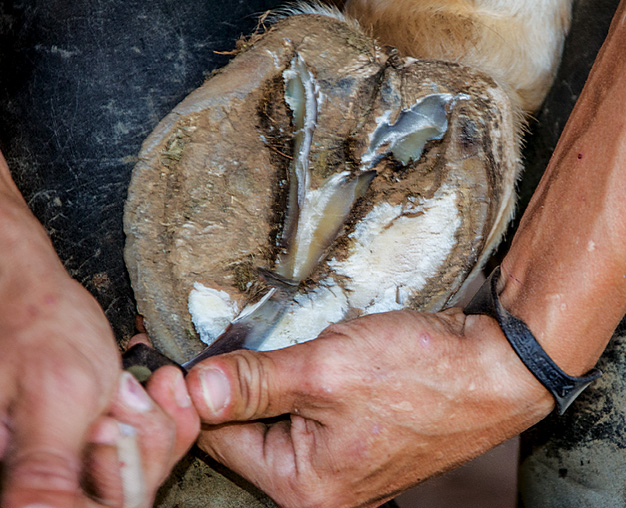
The arid climate of Northern California makes for some hard feet and difficulty paring the sole. “The blade feels like it’s skating over glass,” Ellert says.
10:18 a.m. After finishing up Harley and the final horse — Nicki — Ellert returns to where Grey is trimming the minis and finds her finishing up.
A recent graduate of Pacific Coast Horseshoeing School, Grey divides her time between apprenticing with Ellert and a handful of other farriers in the area, as well as a student instructor at the school.
“Awesome job,” Ellert says while inspecting the trim job.
“It’s amazing how much toe can be taken off such a small foot,” says Grey, who has boundless enthusiasm for learning the trade. “I’ve been picking up some mini tricks. It’s super nice putting the foot on the boot.”
“That’s really helpful to do that,” Ellert replies as she nips away at the hoof of the flea-bitten gray mini. “I like to hold their front legs behind my knee to maintain more control. Sometimes the chaps get in the way.”
Ellert, herself a graduate of Pacific Coast, returns to the school at least once a week to teach and finds that it has made her a better farrier.
“Having a student is probably the best way to look at yourself and your work from the third person,” she says. “It holds you accountable, especially when you have somebody fresh out of shoeing school who challenges you and asks why you are doing the things that you’re doing. It forces you to look at yourself and ask, ‘Why am I doing that? Am I doing it because it’s easier? Am I doing it because it’s the right way?’”
It’s also a good way of breaking out of your comfort zone.
“As farriers, we get a little bit stagnant with our clients,” Ellert says. “Our clients don’t know any better. So, sometimes we get trapped in this world of whatever you’re doing is fine. An apprentice or student challenges you to refocus.”
10:29 a.m. After making minor adjustments to the trim, Ellert and Grey pack up their tools and head to the Starr Vaughn Equestrian Center in Elk Grove, 25 miles southwest of Shingle Springs on U.S. Highway 50.
Ellert will be tending to two Arabian dressage horses — a young gelding and a 7- or 8-year-old mare. While the gelding is barely under saddle, the mare is in low-level competition. She makes it a point to keep up with how her clients perform in the show ring.
“I can’t imagine how you could not be involved as a farrier, because the soundness of these horses depends on you,” Ellert says. “The horse has to be moving at the best of its ability at all times.”
The farrier plays an important role in the horse’s advancement.
“It’s an evolving sport,” she says. “As the horse advances, it starts moving more and more onto the hind end and does more advanced movements. Sometimes you need to add more support as they get up to the higher levels. I don’t think there’s a way you can progress as that horse’s farrier unless you’re paying attention to what that horse is doing.”
Ellert remains in the loop by asking a lot of questions.
“Part of my plan is before I touch the horse, I ask, ‘How was the show? How did you do? What areas need to be improved on? Do you think something could be better? Does something need to change? Are you happy with the status quo? What’s the plan at the next show?’”
Continuing Education Is The
Key To Improving Your Footcare Practice
Marijke Ellert is a big believer in continuing education and what it can do to improve your day-to-day practice. The Placerville, Calif., farrier counts competitions, clinics and conventions among the most helpful in forwarding her career.
Competitions
Competitions can be intimidating. After all, many of them are excellent blacksmiths. Yet, to become good at anything, you have to start some place. For Ellert, it started just 2 years into her farrier career as a 19-year-old.
“I was really reluctant at first to compete because I thought, ‘I can’t go up against all these people,’” she recalls. “‘They’re way better than me. There’s no way that I can compete with them. I’m in a whole different league; they’re so far above me.’”
What Ellert found, though, was that competitors not only are eager to learn, they’re also willing to lend a hand.
“My fellow competitors were so helpful,” she says. “When I had trouble pulling my clips, they’d take me aside in between classes and give me tips.”
That experience has translated into her day-to-day shoeing.
“Competitions are a great part of my career,” Ellert says. “They have forced me to look at my work. A lot of farriers think they know what a good shoeing job is. Until you are judged by your peers or see your peers’ work, you don’t realize that there are areas you can improve. At contests, you will always find someone who is willing to help you fix your problem areas. Competing definitely has given me the skills to be able to make shoes on the fly for horses.”
Although you’ll learn more while actually competing, there’s definitely some merit in watching competitions, as well.
“You also learn just from watching other people compete,” she says. “Just watch how other people do the simple things like pulling clips or how they trim their frog. Learning what the judges are looking for and why the judges are looking for it is a real great way to improve your day-to-day skills.”
Conventions And Clinics
Farrier events, such as conventions and clinics, are opportunities to meet other farriers and veterinarians from far and wide, all while learning your trade.
“I like to travel to different places,” Ellert says. “I like going to the Summit in Cincinnati each year. Sometimes I’ll go to the American Farrier’s Association Convention, depending on where it is. Those things are so fun, and you learn so much.”
While the lectures are the obvious draw, there are others that make a trip like this appealing and worthwhile.
“When you’re at the Summit, you’re with the world’s best veterinarians and farriers,” she says. “They’re right there and you can ask them whatever you want. They’re so willing to offer their knowledge.”
Attending farrier clinics is the easiest and most practical form of continuing education. Many not only are a free educational experience, but they also will feed you.
Not a bad trade off.
12:01 p.m. After lunch, Kaeleb (pronounced Caleb), the young gelding in training, is led into the shoeing stall where Grey gets started cutting clinches and pulling shoes.
“The horses are decent,” Ellert says. “They each have their own little quirks, but they’re good horses.”
Some of the quirkiness comes from the breed itself.
“I own two Arabs, so I’m at least familiar with their idiosyncrasies,” she says. “They’re definitely more difficult. They’re sensitive, I guess is the best way to put it.”
“They’re very good at surviving,” Grey chimes in. “When your survival mode is run away, they do it well.”
After the shoes are pulled, Ellert begins trimming the left front foot. There’s a noticeable difference in how the hoof knife pares Kaeleb’s feet in comparison to the horses at the previous stop.
“I can actually use my knife as a knife, now,” Ellert says.
The 12-year farrier senses that the gelding is sluggish compared to how he usually behaves.
“He’s usually very antsy,” she says. “He seems tired for Kaeleb.”
It turns out, Ellert’s intuition is correct. Kaeleb’s owner rode him for 45 minutes, and then lunged him.
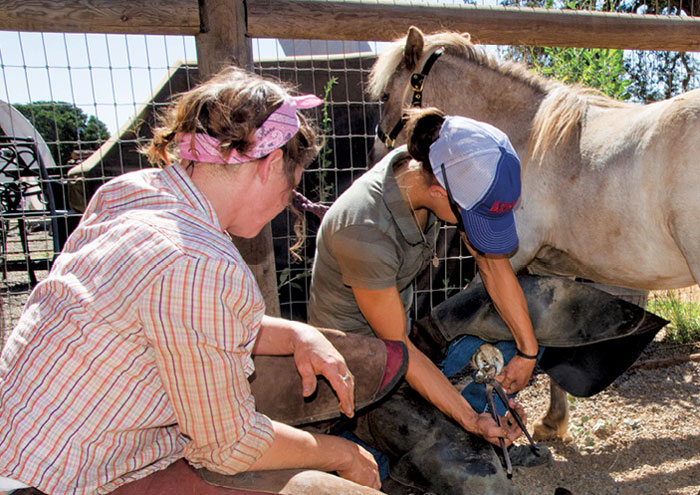
When trimming minis, Ellert demonstrates to her apprentice Carlina Grey that she maintains better control by placing the hoof under her knee.
Since he’s still early in his training, Ellert applies front shoes and keeps the hinds barefoot.
12:56 p.m. After finishing up Kaeleb and returning the gelding to his stall, Mina is brought into the crossties.
“Mina is really weird about her hind end,” Ellert says. “She’s not painful. We had a whole vet work up on her. She just really hates having her hind shoes pulled off and she kicks a lot as a result. I just have to take her shoes off very carefully and use my crease nail pullers instead of my pulloffs.”
Ellert has been shoeing the bay mare for a few years now. When she first came on board, Mina was lame in her heel area.
“She’s got some high-low syndrome,” Ellert says. “The vet and I tried supporting the heels and raising them, but it wasn’t helping. The vet said it might be helpful if there was a way to lessen the impact on her heels.”
Pads are tricky, though, when it comes to the show ring.
“You try to minimize the appliances you put on their feet, because they can get marked down in their scores if the feet don’t look similar,” she says. “So, doing something like putting a pad in one foot versus the other would draw attention.”
So Ellert improvised.
“I set the shoe back a little bit on her low foot and fitted it a little fuller in the heels to support her fetlock,” she says. “Since she tends to get a little heel sore on the high foot, I’ve been grinding the inside edge of the shoe and thinning the ground surface. When that hoof lands in the arena sand, it sinks and takes away some of that impact on her heels. It’s counterintuitive because you don’t want to drop the heel on a high foot too much. But, for whatever reason, it seems to work on this little mare.”
Helping horses is the entire reason why Ellert became a farrier at the tender age of 17.
“The therapeutic part of this job is definitely my favorite,” says Ellert, who is working toward her therapeutic endorsement from the AFA. “I love working with vets and coming up with out-of-the-box ideas and applying them to a horse whose future doesn’t look bright and turning it around. That’s the most rewarding part of this job. I love a lot of my clients and watching my little students rise in their dressage levels and all that, but ultimately I’m in it for the horse. I love being able to make a difference in that horse’s life.”
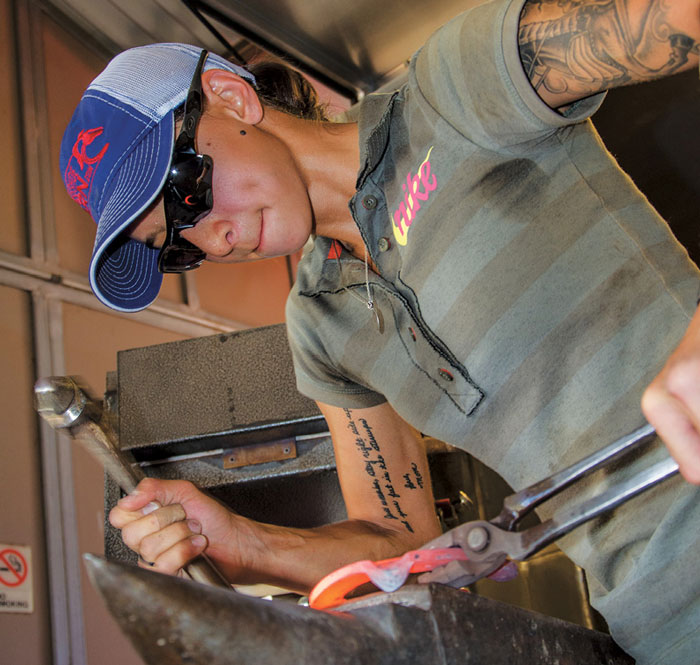
When applying a size 00 or smaller quarter-clipped shoe, Ellert uses only four nails. “That shoe’s not going anywhere,” she says.
It’s a reputation that’s making its way around Ellert’s area.
A vet was brought into a boarding barn to treat a number of lamenesses. Because of the large number, the vet recommended changing farriers.
“The owner of the barn recommended me, because I was working on her horses,” Ellert recalls. “The vet and I went down to the clinic and took X-rays of all the feet. Then based on the radiographs, we developed a shoeing prescription and got them moving just worlds better after just one shoeing. It just improved from there. Now, all of those horses are performing, they’re sound and doing really well.”
The improved performance makes it all the more special because the dressage horses are owned by young girls who are competing and progressing.
“The kids who own these horses are all in lower-level training,” she says. “I think the highest level they’re at is 2. They’ve all moved up levels. It’s been really rewarding to watch the girls grow with these horses.”
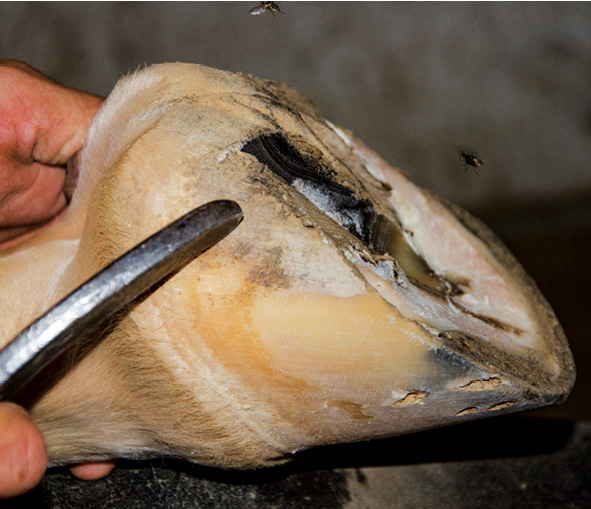
Mina grazes with her left front foot in front of her, causing it to flare and separate at the heels. To manage it, Ellert leaves as much heel as possible while still taking it back to where proper weight bearing should be.
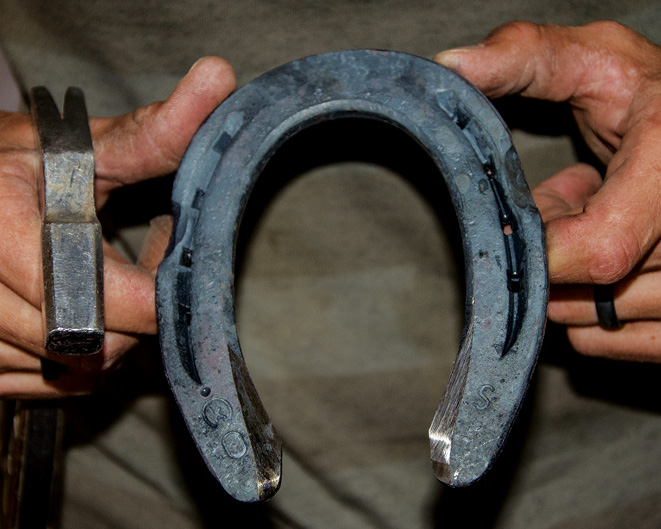
Ellert grinds the inside edge of the shoe and thins the ground surface to allow the hoof to sink in the sand and reduce concussion on the heels.
While Grey cuts the clinches and pulls the bay mare’s front shoes, Ellert fires up her forge to modify four new Kerckhaert Standard shoes.
“She’s kind of base narrow behind,” Ellert says. “She tends to interfere some on her hinds. So, I fullered her lateral heel and gave her some lateral support. That seems to take care of it.”
In addition, she draws quarter clips and seats the toe.
I only use four nails with 00 or smaller shoes …
“I only put four nails in her hinds because her feet are real little,” Ellert says of the size 00 shoes. “I only use four nails with 00 or smaller shoes because the nail holes are so close together and they tend to destroy the hoof. I haven’t had problems — that shoe’s not going anywhere with four nails and quarter clips.”
2:24 p.m. While trimming Mina’s left front foot, Ellert points out that her conformation causes it to flare and separate at the heels.
“She grazes with that left front foot out forward, so she just crushes her heels when she’s out in the pasture,” Ellert says. “Then that right foot being behind, she bears more weight on the toe so those heels grow that way. She’s done that since she was a baby, so at this point, it is what it is. There’s no way to get those horn tubules to start standing up.”
To manage it, Ellert keeps the mare on a 5-week schedule.
“I try to leave as much heel as I can while still taking it back to where proper weight bearing should be, but take a lot of toe,” she explains. “She grows a lot of hoof in 5 weeks.”
After Ellert nails on the shoes, Grey grabs her pink Hoofjack and makes quick work of finishing Mina’s feet.
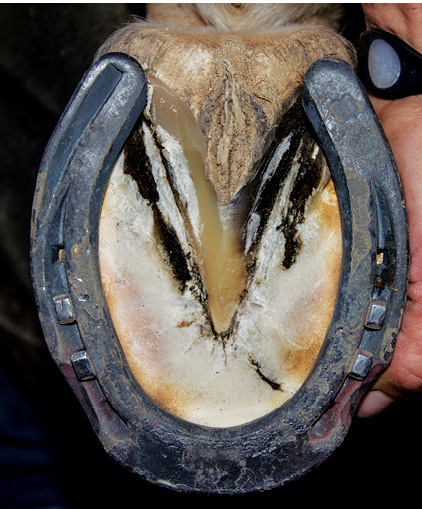
Mina interferes some in the hinds; however, Ellert fullers the lateral heel and provides some lateral support to help the problem.
2:55 p.m. The last stop of the day is at a barn in Sloughhouse, just 15 minutes away. Ellert will be shoeing McCoy, a Welsh Cob stallion that was imported from Denmark by Diane Perry. While Perry’s name might not be familiar, her daughter’s might — Kasey Perry-Glass, who was part of the United States Olympic Dressage Team that won the bronze medal in Rio last month. It was the first dressage Olympic medal for Team USA in 12 years.
McCoy is recovering from a torn subcarpal check ligament in his left front leg.
“You would never know this guy is a stallion,” Ellert says. “He’s so nice and stands really well. He’s been recovering for a long time, at least 6 months. It’s been a really slow process for him.”
It’s imperative to keep McCoy comfortable because if he stops bearing normal weight on his heels, as that check ligament heals, it will atrophy.
“He feet are running forward quite a bit,” she says. “That’s sort of his M.O., the way he grows foot. I’m going to set his shoe back a little bit to move the load bearing back where it should be. We’re always going to be chasing his foot. Unfortunately, shoeing is going to be very uncomfortable with him.”
Initially, Ellert had McCoy in egg bars, but the stallion’s vet deemed them unnecessary and had them removed.
Recently, Ellert was given the greenlight to put the egg bars back on.
“I think it supported his fetlock better,” she says. “It seems to me that he would benefit from having the support back there.”
Ellert examines the shoes after Grey cuts the clinches and pulls them.
“They look like we nailed them on yesterday,” Ellert says. “Poor guy is just standing around.”
Stall rest is imperative to McCoy’s recovery, but it has definite consequences.
“His hoof is petrified from standing in wood shavings all day long,” she says. “It sucks all the moisture out.”

William Shakespeare’s quote from A Midsummer’s Night Dream adorns the back wall of Ellert’s farrier rig.
After trimming the stallion’s feet and cleaning up his shoes, Ellert climbs back under McCoy to nail on the resets. That’s easier said than done, though.
“His feet are so hard,” she says, “that they are redirecting my nails.”
While nailing on his right shoe, Ellert notices McCoy is favoring his left front when he is able.
“He immediately unloads the left one,” she says. “I think it’s still hurting him a little bit.”
4:20 p.m. Grey loads up the rig of the tools and equipment that are no longer needed while Ellert nails on the last shoe.
After Grey is through with finishing McCoy’s feet, Ellert hands the horse over to a groom to return the stallion to his stall.
“You’re such a good boy,” Ellert tells McCoy. “He was trying so hard to stand well, even though he was trembling.”
And though she be little, Ellert is fierce in her passion for horses and her opportunity to help them by “Shoeing For A Living.”

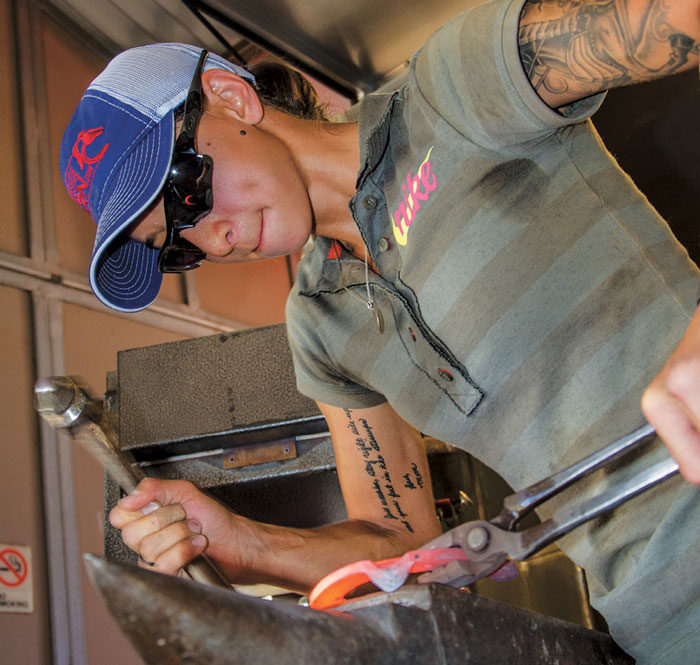






Post a comment
Report Abusive Comment